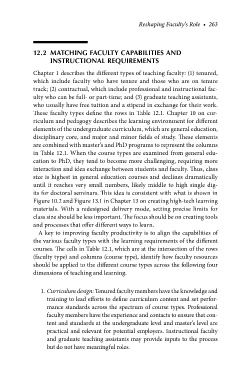Page 292 - Crisis in Higher Education
P. 292
Reshaping Faculty’s Role • 263
12.2 MATCHING FACULTY CAPABILITIES AND
INSTRUCTIONAL REQUIREMENTS
Chapter 1 describes the different types of teaching faculty: (1) tenured,
which include faculty who have tenure and those who are on tenure
track; (2) contractual, which include professional and instructional fac-
ulty who can be full- or part-time; and (3) graduate teaching assistants,
who usually have free tuition and a stipend in exchange for their work.
These faculty types define the rows in Table 12.1. Chapter 10 on cur-
riculum and pedagogy describes the learning environment for different
elements of the undergraduate curriculum, which are general education,
disciplinary core, and major and minor fields of study. These elements
are combined with master’s and PhD programs to represent the columns
in Table 12.1. When the course types are examined from general edu-
cation to PhD, they tend to become more challenging, requiring more
interaction and idea exchange between students and faculty. Thus, class
size is highest in general education courses and declines dramatically
until it reaches very small numbers, likely middle to high single dig-
its for doctoral seminars. This idea is consistent with what is shown in
Figure 10.2 and Figure 13.1 in Chapter 13 on creating high-tech learning
materials. With a redesigned delivery mode, setting precise limits for
class size should be less important. The focus should be on creating tools
and processes that offer different ways to learn.
A key to improving faculty productivity is to align the capabilities of
the various faculty types with the learning requirements of the different
courses. The cells in Table 12.1, which are at the intersection of the rows
(faculty type) and columns (course type), identify how faculty resources
should be applied to the different course types across the following four
dimensions of teaching and learning.
1. Curriculum design: Tenured faculty members have the knowledge and
training to lead efforts to define curriculum content and set perfor-
mance standards across the spectrum of course types. Professional
faculty members have the experience and contacts to ensure that con-
tent and standards at the undergraduate level and master’s level are
practical and relevant for potential employers. Instructional faculty
and graduate teaching assistants may provide inputs to the process
but do not have meaningful roles.

